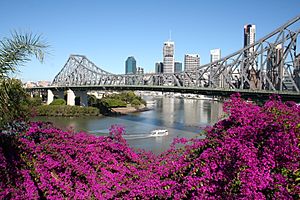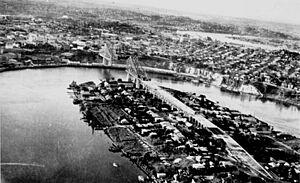Story Bridge facts for kids
Quick facts for kids Story Bridge |
|
|---|---|
 |
|
| Coordinates | 27°27′49″S 153°02′09″E / 27.4635°S 153.0358°E |
| Carries | Motor vehicles and pedestrians |
| Crosses | Brisbane River |
| Locale | Brisbane, Queensland, Australia |
| Official name | Story Bridge |
| Characteristics | |
| Design | Steel cantilever |
| Total length | 777 metres (2,549 ft) |
| Width | 24 metres (79 ft) |
| Height | 74 metres (243 ft) |
| Longest span | 282 metres (925 ft) |
| Clearance below | 30.4 metres (100 ft) at mid-span |
| History | |
| Opened | 6 July 1940 |
The Story Bridge is a famous steel bridge in Brisbane, Queensland, Australia. It's a special type of bridge called a cantilever bridge. It connects the northern and southern parts of Brisbane, carrying cars, bikes, and people over the Brisbane River.
This bridge is the longest cantilever bridge in Australia. The road on it is called the Bradfield Highway. It links Fortitude Valley with Kangaroo Point. The Story Bridge opened in 1940 and was named after John Douglas Story, an important public servant.
Contents
Building the Story Bridge: A Look Back
People in Kangaroo Point wanted a bridge to the city for a long time. Even in 1865, when the first Victoria Bridge was being built, many people asked for a second bridge. They wanted it to connect the city center to Kangaroo Point.
Why Was the Story Bridge Built?
In the 1920s, a plan was made to build several bridges over the Brisbane River. This was to help with traffic jams on the Victoria Bridge. The William Jolly Bridge was the first bridge built from this plan.
Building the Story Bridge was part of a big project during the Great Depression. This was a time when many people needed jobs. The government decided to build the bridge to create work. The plan was to spend no more than £1.6 million on it.
How Was the Story Bridge Constructed?
Before the Sydney Harbour Bridge opened in 1932, the Queensland Government asked engineer John Bradfield to design a new bridge for Brisbane. Bradfield was chosen as the main engineer for the Story Bridge in 1933.
He suggested a steel cantilever bridge, and his design was approved in 1934. The design was similar to the Jacques Cartier Bridge in Montreal, Canada. Two Queensland companies, Evans Deakin and Hornibrook Constructions, won the contract to build it.
Construction started on 24 May 1935. A special factory was built in Rocklea to make parts for the bridge. The Story Bridge has 1.25 million rivets, which are like metal pins holding it together. Sometimes, work went on 24 hours a day!
The bridge has one main support on the northern side. On the southern side, it has two supports: one for weight and one to stop it from twisting. The northern side was anchored into a strong rock cliff.
Overcoming Challenges in Building
The biggest challenge was building the southern foundations. They had to go 40 meters (about 130 feet) deep! Water would quickly fill the holes if they just dug them. So, they used a special method called a pneumatic caisson. This meant workers were in a sealed space with high air pressure.
Working under such high pressure meant workers needed a long time to decompress (slowly return to normal air pressure) after each shift. This helped them avoid a sickness called "the bends." A special hospital was on site to treat workers if they got sick.
The two sides of the bridge met and closed the gap on 28 October 1939. Then, a concrete road surface was added. The bridge was painted, and lights were installed.
Remembering the Workers
Sadly, three men died during the bridge's construction. They were Hans James Zimmerman, Alfred William Jackson, and Arthur McKay (Max) Wharton. These men made a great sacrifice.
Naming the Bridge
Before it was finished, the bridge was called the Jubilee Bridge to honor King George V. It officially opened on 6 July 1940. Sir Leslie Orme Wilson, who was the Governor of Queensland, opened it.
The bridge was named after John Douglas Story. He was a very important public servant who strongly supported building the bridge.
How the Story Bridge is Used Today
The Story Bridge is very busy, with about 97,000 vehicles crossing it every day. It has three lanes for traffic in each direction. There are also paths on both sides for people walking or riding bikes.
The road on the bridge is called the Bradfield Highway. It's important not to confuse it with the Bradfield Highway on the Sydney Harbour Bridge.
Tolls and Public Transport
When the bridge first opened, people had to pay a toll of sixpence (about 5 cents) to cross it. There were toll booths at the southern end. But the toll was removed in 1947.
From 1952 to 1969, electric trolley-buses also used the bridge. After the bridge was finished, new roads and tunnels were built to help traffic flow better around it.
Keeping the Bridge in Good Shape
The Story Bridge needs regular care to stay strong and safe. In 1994, the road surface was redone.
Sometimes, the bridge has to close for important maintenance work. For example, it was closed for a few days in January 2014 to resurface all six lanes. It also closed again in April 2018 for more maintenance.
The Story Bridge in Brisbane's Life
The Story Bridge is a big part of Brisbane's identity. It's lit up at night and is a main feature in the yearly Riverfire display, which is a big fireworks show.
In 1990, the bridge was closed to cars so people could walk across it and celebrate its 50th birthday. On 5 July 2015, nearly 75,000 people walked across the bridge to celebrate its 75th anniversary. They enjoyed food, drinks, and entertainment on the bridge!
Since 2005, people can even climb the bridge! This has become a popular activity for tourists and locals.
Recognizing the Story Bridge's Importance
The Story Bridge is a very important landmark. It was added to the Queensland Heritage Register in 1992, which means it's protected for its historical value.
In 1988, it received a special award from Engineers Australia for its engineering history. In 2009, it was named one of the "Q150 Icons" of Queensland. This recognized its role as an amazing structure and engineering achievement.
Images for kids
-
Governor of Queensland Sir Leslie Orme Wilson and consulting engineer Bradfield inspecting the bridge, 7 July 1938
-
Riverfestival at Story Bridge
See also
 In Spanish: Puente Story para niños
In Spanish: Puente Story para niños






